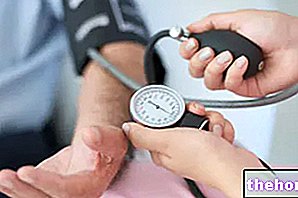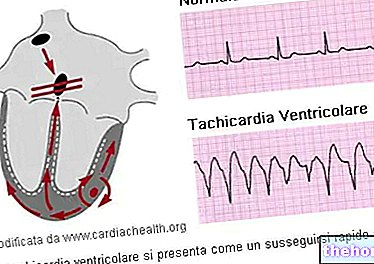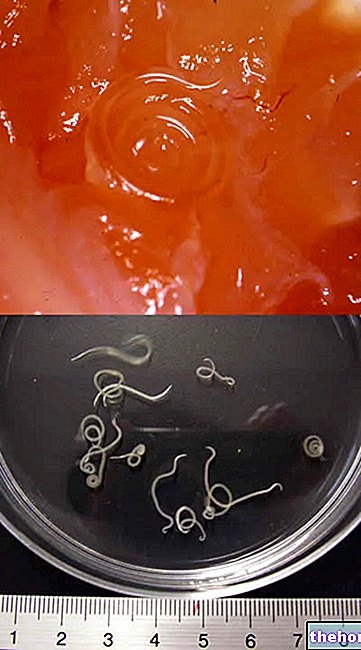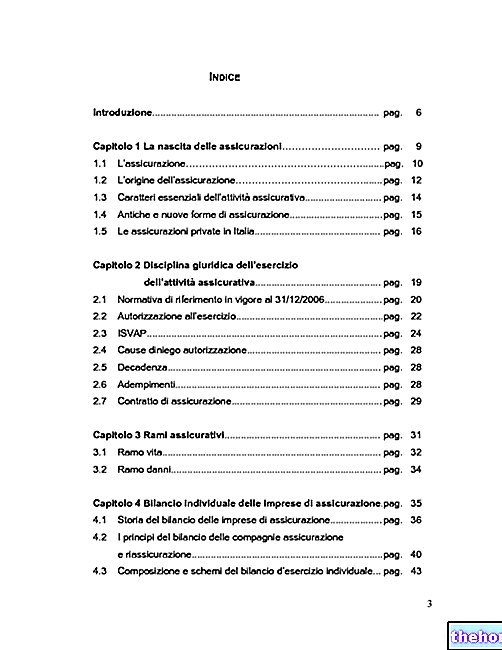What is Endocarditis
Endocarditis is inflammation of the inner lining of the heart (endocardium) and heart valves.
- In most cases, this condition is caused by an infection, while on other occasions it recognizes a non-infectious etiopathogenesis.
- Infective endocarditis is more commonly of bacterial origin, but other pathogens can also determine the onset of the inflammatory process.

Under normal conditions, the immune system recognizes and defends the organism from infectious agents, which - even if they managed to reach the heart - would be harmless, crossing it without causing an infection. However, if the heart structures are damaged as a result of rheumatic fever, birth defects or other diseases, they can be attacked by microorganisms. Under these conditions, it is easier for bacteria to enter the body through the bloodstream. inside the heart, overcoming the normal immune response to infections. When the ideal situation occurs, infectious agents can organize themselves by forming masses called "vegetations" (lesions characteristic of "bacterial endocarditis) at the site of infection, be it a heart valve or other structures of the heart, including implanted devices. the risk of these cell masses acting in a similar way to blood clots, blocking the blood supply to organs and inducing heart failure or triggering a stroke. When analyzed under the microscope, these vegetations show the presence of microcolonies of infecting microorganisms, embedded in a network of platelets, fibrin and a few inflammatory cells.
If endocarditis is neglected, the inflammation can damage or destroy endocardial tissues or heart valves and lead to life-threatening complications. If you have a heart defect, particular medical procedures can create transient bacteremia potentially responsible for endocarditis: tonsillectomy, adenoidectomy, intestinal and respiratory surgery, cystoscopy, bronchoscopy, colonoscopy, etc. The risk of endocarditis also exists when the patient undergoes some dental procedures.
Endocarditis represents a serious disease, capable of inducing very serious medical complications and can also be potentially fatal. Diagnostic confirmation is based on the identification of clinical and microbiological characteristics, with echocardiogram, radiological investigations and blood culture aimed at demonstrating the possible presence Treatments for bacterial endocarditis include the administration of antibiotics and, in severe cases, a surgical procedure.
How bacteria reach the heart
If the heart is healthy, ideal conditions are unlikely to develop for the onset of bacterial endocarditis. In addition, most heart disease (heart disease) also does not increase the risk of the disease occurring.
The interaction between predisposing factors in the host and the inability of the immune system to eradicate the infectious agent from the endocardium makes the patient susceptible to infection.
Bacterial endocarditis occurs when infectious agents enter the bloodstream and manage to "attach" to heart tissue, and then multiply in damaged or surgically implanted heart valves. This damaged tissue in the endocardium provides the ideal location for infectious agents. to settle: the cardiac surface provides them with the support they need to adhere and proliferate. Not all bacteria that enter the bloodstream are capable of causing endocarditis. Only infectious agents presenting tropism to the valvular structures and endocardial tissues - that is, which are able to interact with the surface of the lining of the heart and abnormal valves - can potentially determine the clinical picture of endocarditis.
Bacteria are responsible for the onset of most cases, but fungi or other microorganisms can also be responsible. Sometimes the culprit is one of many common bacteria that live in the mouth, throat or other parts of the body. The offending microorganism can enter. in the blood through:
- Daily activities. Brushing your teeth, chewing food, and other oral activities can allow bacteria to enter the bloodstream. The risk increases if the teeth and gums are in poor condition, as they can be the gateway for bacteria.
- Infections or other medical conditions. Microorganisms can spread from the site of a pre-existing infection (eg gum or skin) to the blood, and from there to the heart. Bacteria can also result from a sexually transmitted disease, such as chlamydia or gonorrhea. intestinal disorders can give bacteria the opportunity to enter the bloodstream.
- Dental and medical procedures. Any medical procedure that involves the placement of an instrument inside the body carries a small risk of introducing bacteria into the bloodstream (for example: operations on the intestinal, genital, urinary tract or removal of the tonsils or adenoids). The same is also true. for some dental procedures that can cause bleeding (avulsions, implantation).
- Bladder catheterization and invasive maneuvers.Bacteria can enter the body through a catheter, a thin tube that is used to empty the bladder (if bladder), for the perfusion of a medicament solution or for the drainage of liquids. The laparoscope is also an instrument that can potentially associate. infection (it is a small flexible tube that has a light source and a camera at one end, used to diagnose and treat a wide range of clinical conditions.) Bacteria that can cause endocarditis can also access the bloodstream through the needles used for a tattoo or piercing.Contaminated syringes are a potential source of infection for people who use intravenous drugs.
Who is at risk
Several factors can make the heart more vulnerable to infection, increasing the likelihood of developing bacterial endocarditis:
- Valve prostheses. Artificial heart valves (biological prostheses or homograft) are used to replace structures damaged by heart disease. Bacteria can settle around prosthetic valves, occasionally triggering endocarditis.
- Congenital heart defects. Congenital heart disease, present from birth, can make the heart more susceptible to infection. Some congenital heart defects (for example: ventricular septal defects, atrial septal defect or patency of the ductus arteriosus) can be surgically repaired and decrease the chance of endocarditis.
- Valvular heart disease and other medical conditions. Rheumatic fever, valvulopathies, atherosclerotic aortic stenosis, prolapsed mitral insufficiency, senile degeneration and other heart diseases can reduce cardiac efficiency and impair valve function.
- Previous infective endocarditis. A previous episode of endocarditis can damage heart tissues and valves, increasing the risk of reinfection.
- Intravenous drug use. Regular heroin or methamphetamine users have a three times higher risk of developing endocarditis than the general population. This condition is mainly caused by repeated injections and the use of non-sterile, often contaminated needles with bacteria that can cause endocarditis.
Endocarditis is more common in older people and in those with congenital heart disease (male / female ratio 2: 1).
Heart disease associated with bacterial endocarditis
Two types of heart disease, in particular, can increase the risk of endocarditis:
- Valve stenosis: narrowing of the valve lumen, with reduction of cardiac efficiency;
- Valvular regurgitation: Heart valves do not close properly, allowing blood to flow back into the heart.
Fungal endocarditis
Endocarditis caused by a fungal infection is rarer and is usually associated with a more severe clinical picture.
The risk of fungal endocarditis increases in case of:
- Surgical intervention;
- Central venous catheter, which consists of a tube connected to a vein in the neck, groin or chest, used to deliver medicines and / or fluids to seriously ill people;
- Weakened immune system, as a result of an immunosuppressive condition (such as HIV) or as a side effect of some types of treatment, such as chemotherapy.
Symptoms
For further information: Symptoms Infective Endocarditis - Symptoms NON-infective Endocarditis
The presenting symptoms of infective endocarditis are highly variable and the extent of the disease can be mild or severe. The clinical features with which the disease onset can be strongly indicative, but the symptoms are often nonspecific. In almost all cases of bacterial endocarditis, an increase in body temperature is found. The combination of some symptoms with particular objective signs, such as a recent heart murmur, will allow the doctor to consider endocarditis as the source of the problem. The subsequent diagnostic investigations will allow to evaluate the health conditions of the heart and to identify the agent. responsible infectious.
There are two ways that endocarditis symptoms can begin:
- Over the course of a couple of days, rapidly worsening (acute endocarditis);
- Slowly, over the course of a couple of weeks or possibly months (subacute endocarditis).
Subacute endocarditis is more common in people with congenital heart disease. The initial symptoms of bacterial endocarditis are flu-like and may be the only signs that arise. These include:
- Fever (> 38 ° C);
- Asthenia;
- Chills;
- Loss of appetite
- Headache;
- Joint and muscle pain
Less common symptoms of endocarditis are:
- Night sweats
- Shortness of breath
- Unexplained weight loss
- Pallor;
- Persistent cough;
- Heart murmur and heart rhythm disturbance
- Septic embolism (30% of cases) in the skin, palate and conjunctiva, with characteristic signs such as Janeway lesions (painless hemorrhagic skin lesions on the palms of the hands and soles of the feet) and petechiae;
- Localized edema in the hands, legs or feet
- Splenomegaly;
- Anemia and leukocytosis;
- Blood in the urine
- Mental confusion;
- Thromboembolic problems: stroke in the parietal lobe or gangrene of the fingers, intracranial hemorrhage, conjunctival hemorrhage, renal embolic infarcts or splenic infarcts;
- Immune complex disorders: focal or diffuse glomerulonephritis, Osler's nodules (painful periungual lesions), Roth's spots on the retina, rheumatoid factor positive etc.




























